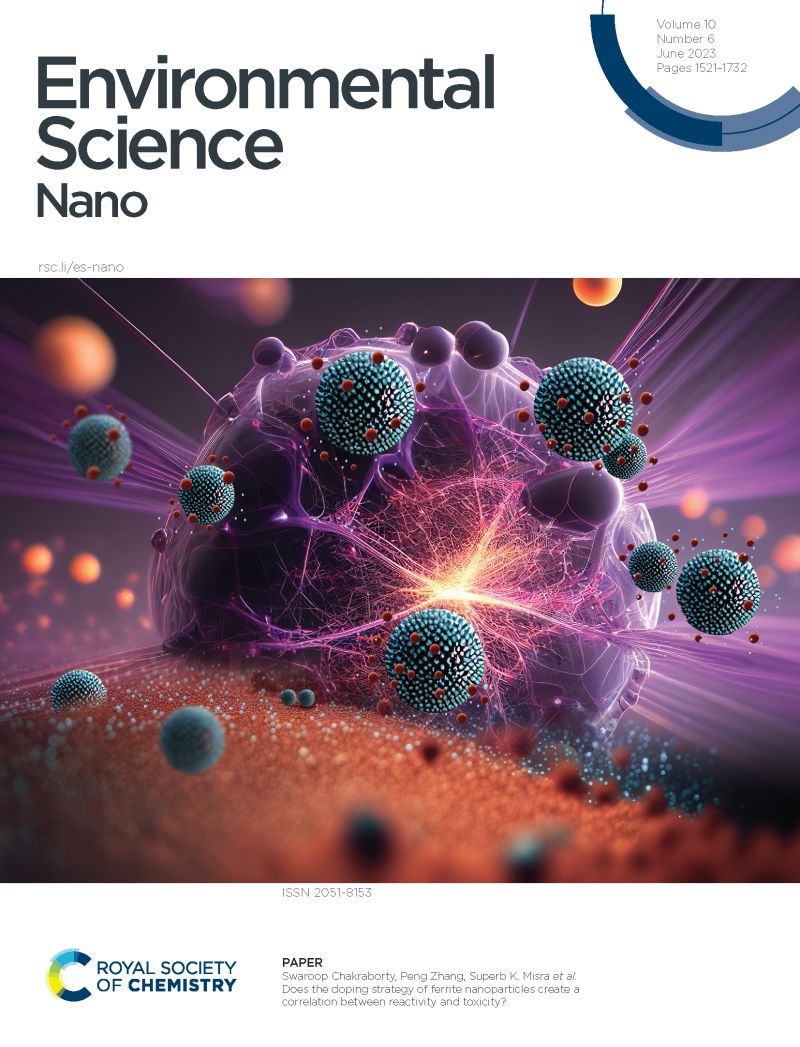聚苯乙烯纳米颗粒的尺寸和紫外线老化对铜(II)吸附的影响:水生环境中的动力学和等温线
IF 5.8
2区 环境科学与生态学
Q1 CHEMISTRY, MULTIDISCIPLINARY
引用次数: 0
摘要
塑料微粒通过吸附作用成为有毒重金属载体的可能性一直备受关注。对于这一过程所涉及的机制,人们对纳米级颗粒的研究尤其不足。为了弥补这一空白,我们报告了在模拟水生环境条件下,有紫外线老化和无紫外线老化时 Cu2+ 离子在聚苯乙烯纳米颗粒(PS-NPs)上的吸附情况。合成的不含表面活性剂的 PS-NPs 平均直径分别为 130、260 和 520 nm。PS-NPs 的扫描电子显微镜和动态光散射表征显示,紫外线老化后,随着粒径的减小,其不稳定性和聚集性会增加。虽然 PS-130 纳米最初在去离子水中表现出更高的 Cu2+ 吸附能力,但在紫外线老化后,由于 PS-130 纳米的胶体不稳定性更高,这一数值转而有利于 PS-260 纳米。然而,在海水中,与去离子水相比,所有样品的吸附能力都降低了 3-4 倍,同时平衡时间也加快了,这归因于海水中离子的竞争。在紫外线老化的 PS-NPs 表面,X 射线光电子能谱分析表明,吸附后 Cu(OH)2 键增加,导致吸附活化能比原始样品增加。吸附等温线倾向于 Freundlich 模型,每种介质的吸附等温线形状各不相同,而且随着粒度和/或温度的增加,吸附等温线趋于线性。热力学计算表明,吸附相互作用是放热的,此外,较小颗粒的吸附自发性更高。这项研究加深了我们对 PS-NPs 在水生环境中行为的了解,为今后探索金属离子与复杂塑料纳米粒子的相互作用铺平了道路。本文章由计算机程序翻译,如有差异,请以英文原文为准。
Impact of Size and UV-ageing of Polystyrene Nanoparticles on Copper(II) Adsorption: Kinetics and Isotherms in Aquatic Environments
There has been substantial concern over the potential for plastic particles to serve as vectors for toxic heavy metals through adsorption. The mechanisms involved in this process are particularly understudied in the context of nano-sized particles. To address this gap, we report the adsorption of Cu2+ ions onto polystyrene nanoparticles (PS-NPs) in simulated aquatic environmental conditions, with and without UV-ageing. Surfactant-free PS-NPs were synthesised with average diameters of 130, 260 and 520 nm. Scanning electron microscopy and dynamic light scattering characterisation of PS-NPs revealed increased instability and aggregation with decreasing particle size, following UV-ageing. While PS-130 nm initially exhibited higher Cu2+ adsorption capacity in DI water, this value shifted in favour of PS-260 nm after UV-ageing, due to higher colloidal instability of PS-130 nm. Yet, in seawater, 3-4 times reduction in adsorption was observed for all the samples, compared to DI water, alongside accelerated equilibrium times, attributed to the competition of ions in seawater. On the surface of UV-aged PS-NPs, X-ray photoelectron spectroscopy analysis showed an increase in Cu(OH)2 bonds after adsorption, resulting in increased activation energy of adsorption compared to original samples. Adsorption isotherms favoured the Freundlich model, highlighting a distinct isotherm shape for each medium and a tendency toward a linear isotherm as the particle size and/or temperature increased. Thermodynamic calculations showed the adsorption interaction was exothermic, in addition to the higher spontaneity of adsorption by smaller particles. This research enhances our understanding of PS-NPs behaviour in aquatic environments, paving the way for exploring metal ions’ interaction with complex plastic nanoparticles in future studies.
求助全文
通过发布文献求助,成功后即可免费获取论文全文。
去求助
来源期刊

Environmental Science: Nano
CHEMISTRY, MULTIDISCIPLINARY-ENVIRONMENTAL SCIENCES
CiteScore
12.20
自引率
5.50%
发文量
290
审稿时长
2.1 months
期刊介绍:
Environmental Science: Nano serves as a comprehensive and high-impact peer-reviewed source of information on the design and demonstration of engineered nanomaterials for environment-based applications. It also covers the interactions between engineered, natural, and incidental nanomaterials with biological and environmental systems. This scope includes, but is not limited to, the following topic areas:
Novel nanomaterial-based applications for water, air, soil, food, and energy sustainability
Nanomaterial interactions with biological systems and nanotoxicology
Environmental fate, reactivity, and transformations of nanoscale materials
Nanoscale processes in the environment
Sustainable nanotechnology including rational nanomaterial design, life cycle assessment, risk/benefit analysis
 求助内容:
求助内容: 应助结果提醒方式:
应助结果提醒方式:


